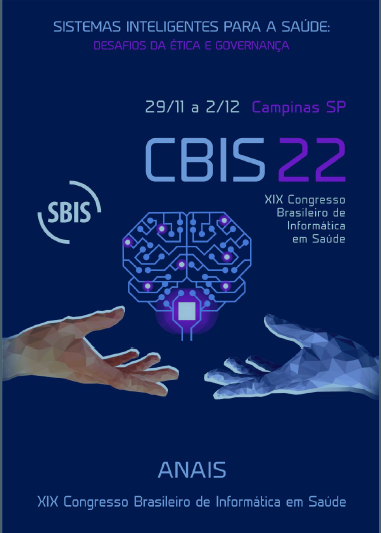Automatic identification of the use of face protection masks: a comparative study
DOI:
https://doi.org/10.59681/2175-4411.v15.iEspecial.2023.1077Keywords:
Mask, Machine Learning, Deep LearningAbstract
Objectives: The use of protective masks is an important measure to reduce the transmission of COVID-19 and other diseases. The present work aims to carry out a comparative study between different deep learning models applied to the identification of face masks (person without mask, with mask or with incorrectly positioned mask). Methods: Convolutional Neural Network models MobileNetV3, Xception, VGG19 were implemented and evaluated. The transfer of learning technique was used in the implementation and adjustment of these models. Results: The evaluated models presented accuracies that varied between 42% and 86%, the latter obtained by the Xception model, surpassing the results reported in the related literature. Conclusion: The results point to the promising potential of the Xception model, which, by enabling automatic monitoring, allows people to be guided on the correct use of protective masks, thus helping to reduce the spread of diseases through the airways.
References
Freitas CM, Barcellos C, Villela DAM, organizadores. Covid-19 no Brasil: cenários epidemiológicos e vigilância em saúde [Internet]. Série Informação para ação na Covid-19. Fiocruz; 2021. doi: https://doi.org/10.7476/9786557081211
Organização Pan-Americana da Saúde. Orientação sobre o uso de máscaras no contexto da COVID-19: Orientação provisória, 6 de abril de 2020.
Agência Nacional de Vigilância Sanitária (Brasil). Nota técnica GVIMS/GGTES/ANVISA nº 03/2022: orientações para prevenção e controle da Monkeypox nos serviços de saúde. Brasília: ANVISA; 2022.
Pereira Junior A, Teixeira F, Homem T. Aplicação de visão computacional para o monitoramento do uso de máscaras de proteção. CONICT. 2020.
Costa VL, Teixeira EH, Mafra SB, Rodrigues JJPC. On the Performance Analysis of a TensorFlow based Neural Network for Face Mask Detection. 2021 IWCMC. 2021.
Das A, Ansari MW, and Basak R, Covid-19 Face Mask Detection Using TensorFlow, Keras and OpenCV. 2020 IEEE 17th INDICON. 2020, 1-5, doi: 10.1109/INDICON49873.2020.9342585.
Quiñonez-Cuenca F, Maza-Merchán C, Cuenca-Maldonado N, Quiñones-Cuenca M, Torres R, Sandoval F, et al. Evaluación de AIoT en modelos computacionales en la nube y en el borde aplicado a la detección de mascarillas. Ingenius. 2022 Jun; (27).
Vich I. Medical masks dataset images tfrecords [Internet]. Kaggle. 2020. [cited 2022 Jun 06]. Available from: https://bit.ly/3er0tb8
Ge S, Li J, Ye Q, Luo Z. MAFA [Internet]. 2018. [cited 2022 Jun 06]. Available from: https://bit.ly/3FBC52o
Siradjuddin IA, Agustien, Muntasa A. Faster Region-based Convolutional Neural Network for Mask Face Detection. 5th ICICoS. 2021. 282-286, doi: 10.1109/ICICoS53627.2021.9651744.
Mangalampalli R. MAFA data [Internet]. Kaggle. 2020. [cited 2022 Jun 10]. Available from: https://www.kaggle.com/datasets/rahulmangalampalli/mafa-data
DataFlair. Download Face Mask Data – DataFlair [Internet]. [cited 2022 Jun 08]. Available from: https://data-flair.training/blogs/download-face-mask-data/
Wang Z, Wang G, Huang B, Xiong Z, Hong Q, Wu H, et al. Masked face recognition dataset and application. arXiv; 2020. doi https://doi.org/10.48550/arxiv.2003.09093
Bhandary P. Prajnasb [Internet]. Github. 2020. [cited 2022 Jun 12]. Available from: https://github.com/prajnasb/observations/tree/master/experiements/data
Maranhão A. Face Mask Detection [Internet]. Kaggle. 2020. [cited 2022 Jun 12]. Available from: https://www.kaggle.com/andrewmvd/face-mask-detection
Howard A, Sandler M, Chu G, Chen L-C, Chen B, Tan M, et al. Searching for MobileNetV3 [Internet]. arXiv; 2019. doi: 10.48550/ARXIV.1905.02244 [cited 2022 Jun 25]. Available from: https://arxiv.org/abs/1905.02244
Chollet F. Xception: Deep learning with depthwise separable convolutions [Internet]. arXiv; 2017. doi: 10.48550/ARXIV.1610.02357 [cited 2022 Jun 27]. Available from: https://arxiv.org/abs/1610.02357
Simonyan K, Zisserman A. Very Deep Convolutional Networks for Large-Scale Image Recognition. arXiv; 2014. doi: 10.48550/ARXIV.1409.1556
Krizhevsky A, Sutskever I, Hinton GE. Imagenet classification with deep convolutional neural network. Advances in neural information processing systems 2012; 25.
NVIDIA. FFHQ dataset [Internet]. 2019. [cited 2022 Jun 25]. Available from: https://github.com/NVlabs/ffhq-dataset
Cabani A, Hammoudi K, Benhabiles H, Melkemi M. MaskedFace-Net – A dataset of correctly/incorrectly masked face images in the context of COVID-19. Smart Health. 2021; 19. [cited 2022 Jun 25]. Available from: https://www.sciencedirect.com/science/article/pii/S2352648320300362
Hammoudi K, Cabani A, Benhabiles H, Melkemi M. Validating the correct wearing of protection mask by taking a selfie: design of a mobile application "CheckYourMask" to limit the spread of COVID-19. CMES-Computer Modeling in Engineering & Sciences. 2020. 124 (3):1049-59.
Abadi M, Agarwal A, Barham P, Brevdo E, Chen Z, Citro C, Corrado G, et al. TensorFlow: Large-Scale Machine Learning on Heterogeneous Distributed Systems. arXiv; 2016. doi 10.48550/ARXIV.1603.04467.
Chollet F, et al. Keras [Internet]. GitHub; 2015. [cited 2022 Jun 29]. Available from: https://github.com/fchollet/keras.
Géron A. Mãos à Obra Aprendizado de Máquina com Scikit-Learn e TensorFlow: Conceitos, Ferramentas e Técnicas Para a Construção de Sistemas Inteligentes. Rio de Janeiro: Alta Books; 2019.
Downloads
Published
How to Cite
Issue
Section
License
Copyright (c) 2023 José Voltan, Ronaldo Goldschmidt, Jefferson Oliva, Julio Duarte, Dalcimar Casanova, Marcelo Teixeira

This work is licensed under a Creative Commons Attribution-NonCommercial-ShareAlike 4.0 International License.
Submission of a paper to Journal of Health Informatics is understood to imply that it is not being considered for publication elsewhere and that the author(s) permission to publish his/her (their) article(s) in this Journal implies the exclusive authorization of the publishers to deal with all issues concerning the copyright therein. Upon the submission of an article, authors will be asked to sign a Copyright Notice. Acceptance of the agreement will ensure the widest possible dissemination of information. An e-mail will be sent to the corresponding author confirming receipt of the manuscript and acceptance of the agreement.

